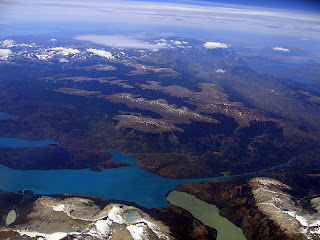http://cartinafinland.fi/en/imagebank/image/84/84223/Andes%2Bmountains,%2BArgentina.%2B84223.jpg&imgrefurl
The Andes continue to grow as the lithosphere begins "rafting" on the asthenosphere.
Caption: A aerial view shot of Patagonia taken from Chile.
http://en.wikipedia.org/wiki/File:Patagonia_aerial.jpg
Caption: The picture above shows a fault-line scarp of a normal fault in the Andes.
This normal fault was formed by the process of extension.
http://www.google.com/imgres?imgurl=http://ic.ucsc.edu/~casey/eart150/Lectures/3NormStrkSlpFlts/AndesNrmlFlt.mod.jpg&imgrefurl
The Copahue Volcano below is an active stratovolcano. It is composed of andesite and has a composite cone with a caldera of twelve miles in diameter. Since this volcano is near a lake, many geysers exist due to the geothermal activity. During an eruption, this stratovolcano expels lava with high viscosity. In the last eruption of Copahue, pyroclastics such as tephras, cinders, and bombs were emitted. Being near the eruption, locals and tourists inhaled this dangerous ash. With this volcano surrounded by snow, it is probable that there were lahars.
http://travellingboard.net/wp-content/uploads/2008/06/copahue.jpg
Caption Below: The video below gives a great 360 degree view at the solfatara field of the Copahue volcano and shows numerous, basalt-lava flows and dikes.
Caption Below: A great example of isostatic balance is shown in the glaciers near Patagonia.
http://www.google.com/imgres?imgurl=http://portraithouse.net/wp-content/uploads/2010/01/Perito_Moreno_Glacier_Patagonia_Argentina_Luca_Galuzzi_2005.jpg&imgrefurl
As the glacier recedes and the ice melts, the crust (lithosphere) shows isostatic rebound.
Below: Perito Moreno Glacier
http://www.google.com/imgres?imgurl=http://www.hostelbloggers.com/wp-content/uploads/2008/08/argentina-perito_moreno-glacier.jpg&imgrefurl
Works Cited
http://www.patagonia-argentina.com/i/
http://www.blueplanetbiomes.org/andes.htm
http://volcano.oregonstate.edu/vwdocs/volc_images/south_america/chile/copahue.html
http://www.volcanolive.com/copahue.html
http://science.jrank.org/pages/6300/South-America-Andes.html
http://www.wesleyan.edu/ees/JCV/vlsa1.html





